
HOME
INTRO
SYMBOLS
ALMANAC
ECONOMY
GEOGRAPHY
STATE MAPS
PEOPLE
FORUM
NEWS
COOL SCHOOLS
STATE QUIZ
STATE LINKS
BOOK STORE
MARKETPLACE
GUESTBOOK
CONTACT US


Tweet
Double click on word for definition.
Texas State Amphibian
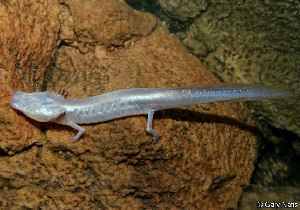
Texas State Wannabee: Texas Blind Salamander
U.S. Fish and Wildlife Service © Gary Nafis
Was it Danbury Independent School District Librarian Ace Filipp who planted the idea of an official state amphibian for the State of Texas?
Justin Horne, at KIAH Television, quotes Ace Fillip:
"It was a research project. It initially started off as a research project where we could incorporate a library doing research using the data bases and books from the library."
(Horne)
The research project led fourth grade students from Danbury Elementary School to discover that Texas did not have an official state amphibian. The student's research also led them to determine that the best candidate for the role of official amphibian was the Texas blind salamander (Eurycea rathbuni). They brought their idea to State Representative Dennis Bonnen.
"They contacted my office and said that we have found that we don't have a State Amphibian. We think we should and we're to going to solve that problem for Texas."
(Horne)
Rep. Bonner crafted legislation and House Concurrent Resolution No. 30 (HCR30) was filed on January 11, 2007.
The resolution passed in the House and it passed in the Senate and, on May 15, 2007, it was sent to the Governor for his approval.
Governor Rick Perry refused to sign House HCR30, proposing the Texas blind salamander as the official State Amphibian of Texas. In an official May 26, 2007 proclamation, Governor Perry explained his reasons for not signing the resolution.
The official designation of items and objects as much-loved objects of Texas should represent the entire state and not just one region or locality. This resolution designates an amphibian as the official State Amphibian of Texas that is found in only one Texas county. Such a small area does not adequately represent the State of Texas as a whole. Therefore, I am not signing HCR 30 by Bonnen.
("House Journal, Eightieth Legislature, Regular Session" 6668)
The Texas blind salamander is only found in underwater limestone caverns of the Edwards Aquifer and in Spring Lake when forced above ground by springs that feed the San Marcos River. One of the six endangered and threatened species found in the Edwards Aquifer, in 1967 it was the first species named to the Federal Endangered Species List.
Dianne Wassenich, Executive Director of the San Marcos River Foundation, did not take Governor Perry's effective veto lightly.
?I guess its[sic] consistent with the Legislature?s decision to raise the pumping caps. It?s too bad that they don?t understand what a unique and special species this particular salamander is,? Wassenich said.
(Rollins)
The students were disappointed. Ace Filipp summed it up in an article in the Houston Chronicle.
?Our students left school and thought it was passed, not thinking the governor would veto. They were disappointed. A lot of them said they were going to write letters.?
(Saleh Rauf)
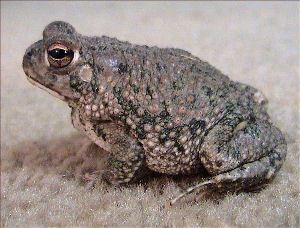
Texas State Amphibian: Texas Toad
Two years later, Rep. Bonnen was back with a new proposal from Danbury Elementary School. This time the students had help from the Texas Parks & Wildlife Department (TPWD).
TWDP biologists offered five candidates for the state amphibian slot to the Danbury Elementary School fourth grade class.
- Texas toad (Bufo speciosus)
- Barred tiger salamander (Ambystoma tigrinum mavortium)
- Strecker's chorus frog (Pseudacris streckeri)
- Cliff-chirping frog (Eleutherodactylus marnockii)
- Houston toad (Bufo houstonensis)
The students formed five groups, each assigned to represent one of the amphibians recommended by the TWDP. Each group researched and campaigned for their candidate for officialdom. They created campaign signs, commercials, and gave speeches.
Based on research and campaigns the students voted for the one amphibian that they would support in a new proposal for an official state amphibian. The Texas toad won the contest by three votes, barely defeating the second place finisher, the barred tiger salamander.
Rep. Bonnen filed House Concurrent Resolution No. 18 (HCR18) on January 13, 2009.
H.C.R. No. 18
HOUSE CONCURRENT RESOLUTION
WHEREAS, The State of Texas traditionally has recognized a variety of official symbols as tangible representations of the proud character and colorful heritage of the Lone Star State; and
WHEREAS, Select members of the animal kingdom, including the longhorn, the armadillo, and the Guadalupe bass, are among the species that have been officially recognized, and their designation has served to draw attention to the great biological diversity of the Texas landscape and to highlight creatures who are unique to or closely identified with the state; and
WHEREAS, The large variety of natural habitats in Texas as well as the state?s central location on the North American continent have given it a rich array of amphibians; of the many members of that class that share our lands and waters, one species comes immediately to the forefront as an especially worthy symbol of the state: the Texas toad; and
WHEREAS, Aptly named, the Texas toad lives primarily in the Lone Star State, though it is also found in the neighboring areas of New Mexico, Oklahoma, and northern Mexico; known by the scientific name Bufo speciosus, it is one of the most abundant toad species in Texas and resides in nearly all regions of the state with the exception of the far eastern counties and parts of the western Panhandle; and
WHEREAS, Ranging in color from gray to brown with dark irregular markings, the Texas toad can grow to more than three inches in length and is easily identified by the black tubercles on its hind feet and by the absence of the back stripe that is seen on many other toads; and
WHEREAS, These adaptable amphibians demonstrate the hardy determination that Texans are known for; in order to survive in a place where the sun is fierce and water can be scarce, they are adept at taking refuge beneath rocks and in below-ground havens; while most well suited to live in areas of sandy soil, they also thrive in other locales and are found in environments that range from desert to grasslands to wooded areas; and
WHEREAS, Relishing nothing more than a cooling shower, Texas toads emerge in huge numbers following a summer rain and head for the nearest pool of water in hopes of finding a mate; the toads have a distinctive sound, with males emitting a call of explosive trills to charm their lady friends; and
WHEREAS, Possessing a Buddha-like visage, this notable creature is a common sight across much of Texas, and its indomitable spirit and unique relationship with the state for which it was named make it a most appropriate symbol of the Lone Star State; now, therefore, be it
RESOLVED, That the 81st Legislature of the State of Texas hereby designate the Texas toad as the official State Amphibian of Texas.
Again, a state amphibian resolution made its way through the House and then the Senate.
On May 26, 2009 HCR18 was sent to Governor Perry for his signature.
This time the amphibian proposed to become the official amphibian of the State of Texas enjoyed a wide distribution within the state. Per HCR18, the Texas toad "is one of the most abundant toad species in Texas and resides in nearly all regions of the state with the exception of the far eastern counties and parts of the western Panhandle."
On June 19, 2009, Governor Rick Perry signed House Concurrent Resolution No. 18, making the Texas toad the official amphibian of the State of Texas.
According to then fifth grader Zack Rusnak,
"It makes me feel like we are going to be put in the history books. So when the kids learn about the Texas Toad, we can remember we were the ones that made it our State Amphibian."
(Horne)
Texas Law
The Texas toad was named the official state amphibian of the State of Texas by House Concurrent Resolution and is not, therefore, listed in the Texas Statutes.
Only a small number of Texas' myriad symbols have been actually adopted by an act of the legislature and written into the Texas Statutes.
Sources...
Horne, Justin. "State Amphibian Named By Local Students." KIAH-TV Channel 39. KIAH Television, 13 Dec 2009. Web. 27 Sep 2011.
Saleh Rauf, David. "4th-graders have hearts set on naming state amphibian." The Houston Chronicle. The Houston Chronicle, 13 Dec 2009. Web. 27 Sep 2011.
"Bill: HCR 118, Legislative Session: 81(R)." The Legislature of the State of Texas. The State of Texas, 2009. Web. 27 Sep 2011.
"Bill: HCR 30, Legislative Session: 80(R)." The Legislature of the State of Texas. The State of Texas, 2007. Web. 27 Sep 2011.
State of Texas. House Journal, Eightieth Legislature, Regular Session. Austin: State of Texas, 2007. Web.
Additional Information
Toads : The National Wildlife Federation.
Texas Toad, Bufo speciosus: Checklist of Amphibian Species and Identification Guide.
Anaxyrus speciosus Photographs: CalPhotos, a project of the Biodiversity Sciences Technology group (BSCIT), part of the Berkeley Natural History Museums at University of California, Berkeley.
Anaxyrus speciosus Texas Toad: Encyclopedia of Life.
Bufo speciosus (Texas toad): The University of Michigan Museum of Zoology, Animal Diversity Web.
Anaxyrus speciosus - (Girard, 1854) Texas Toad: NatureServe. 2011. NatureServe Explorer: An online encyclopedia of life. Version 7.1. NatureServe, Arlington, Virginia.
Bufo speciosus - Girard, 1854: Integrated Taxonomic Information System (ITIS), National Museum of Natural History, Washington, D.C..
Official state amphibians: Complete list of official state amphibians from NETSTATE.COM.
More symbols & emblems: Complete list of official Texas state symbols from NETSTATE.COM.
What is an Amphibian? (The Science of Living Things) , by Bobbie Kalman and Jacqueline Langille, 32 pages, Crabtree Publishing Company (2000). Reading level: Ages 9-12. The large, full-color photographs and illustrations that pepper every page of these books will catch the eye of browsers but it is the informative, easy-to-read texts that will hold their interest.
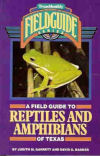
A Field Guide to Reptiles and Amphibians of Texas, by Judith M. Garrett and David G. Barker. 225 pages. Publisher: Texas Monthly Pr (November 1987) Provides photos and text for all Texas species, except snakes (found in a separate guide).
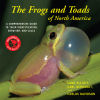
The Frogs and Toads
of North America
The Frogs and Toads of North America: A Comprehensive Guide to Their Identification,Behavior, and Calls, by Lang Elliott, Carl Gerhardt, Carlos Davidson. 344 pages. Publisher: Mariner Books (March 17, 2009) A beautiful and comprehensive photo-filled guide that is the first to show all of the frogs of North America and includes a CD of their calls Colorful and noisy early indicators of environmental distress, frogs and toads are fascinating to casual nature lovers as well as expert herpetologists. Covering all 101 species in the United States and Canada, this book contains natural history information, identification tips, range and habitat information, summaries of behavior, and descriptions of calls.
A 70-minute audio compact disc includes the calls of nearly every species and makes fascinating listening for any nature lover.The book also has sections on conservation issues, public participation in census programs, photography and sound recording, and keeping frogs and toads as pets.
From the olive-and-black Pig Frog, which gets its name from its low-pitched, piglike grunt, to the X-marked and familiar-sounding Spring Peeper, the superb photographs and high-quality field recordings combine with the informative text to make this a must-have book for every naturalist.
Peterson First Guide to Reptiles and Amphibians , by Robert C. Stebbins, Joseph T. Collins and Roger Conant. Edited by Roger Tory Peterson. 128 pages, Houghton Mifflin Harcourt (April 15, 1999). From mudpuppies to rattlesnakes, this fascinating guide for young nature lovers describes the habits and habitats of these secretive and sometimes bizarre animals, and includes tips on how to catch and care for frogs, snakes, turtles, lizards, salamanders, and toads.
Reptiles & Amphibians for Dummies, by Patricia Bartlett, 360 pages, For Dummies; 1st edition (June 1, 2003) This essential guide tells you what you must know before you own a reptile or amphibian, with authoritative advice on everything from proper caging and feeding to health care, socializing, transporting, and more. You'll find out about the different species, normal and abnormal behavior, the basics of breeding, and complying with laws.
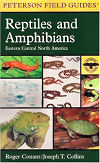
A Field Guide to Reptiles & Amphibians of Eastern & Central North America, by Roger Conant and Joseph T. Collins, 640 pages, Houghton Mifflin Harcourt; Fourth Edition edition (May 15, 1998). This newly designed field guides features detailed descriptions of 595 species and subspecies. The 656 full-color illustrations and 384 drawings show key details for accurate identification. More than 100 color photographs and 333 color photographs and 333 color distribution maps accompany the species descriptions.
Firefly Encyclopedia of Reptiles and Amphibians, edited by Tim Halliday and Kraig Adler, 240 pages, Firefly Books (September 7, 2002). With lush color photographs and lavishly detailed illustrations, this encyclopedia presents a striking abundance of information at a glance. Also noteworthy is the scholarly text, a comprehensive overview of these frequently studied phyla.
Frogs, Toads, and Treefrogs: Everything About Selection, Care, Nutrition, Breeding, and Behavior, by R. D. Bartlett and Patricia P. Bartlett. 104 pages. Barron's Educational Series (February 1, 1996) This manual includes detailed instructions for maintaining a proper terrarium, taking preventative measures against parasites and disease, ensuring a healthful diet for your amphibians, profiles of popular species, and more.

